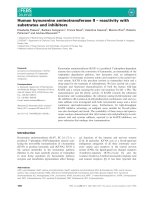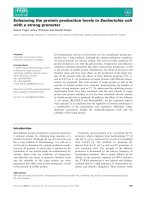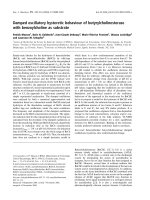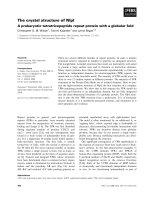Treating Pediatric Bed-wetting with Acupuncture & Chinese Medicine potx
Bạn đang xem bản rút gọn của tài liệu. Xem và tải ngay bản đầy đủ của tài liệu tại đây (1.26 MB, 249 trang )
Treating Pediatric
Bed-wetting with
Acupuncture &
Chinese Medicine
by Robert Helmer
Blue Poppy Press
Published by:
BBLLUUEE PPOOPPPPYY PPRREESSSS
AA DDiivviissiioonn ooff BBlluuee PPooppppyy EEnntteerrpprriisseess,, IInncc
55444411 WWeesstteerrnn AAvvee ,, SSuuiittee 22
BBOOUULLDDEERR,,
CCOO 8800330011
FFiirrsstt EEddiittiioonn,, FFeebbrruuaarryy,, 22000066
ISBN 978-1-891845-33-0
LC 2005938717
CCOOPPYYRRIIGGHHTT ©© BBLLUUEE PPOOPPPPYY PPRREESSSS,, 22000066 AAllll RRiigghhttss RReesseerrvveedd
All rights reserved. No part of this book may be reproduced, stored in a retrieval
system, transcribed in any form or by any means, electronic, mechanical, photocopy,
recording, or any other means, or translated into any language without the prior
written permission of the publisher.
DISCLAIMER: The information in this book is given in good faith. However, the
author and the publishers cannot be held responsible for any error or omission. The
publishers will not accept liabilities for any injuries or damages caused to the reader
that may result from the reader’s acting upon or using the content contained in this
book. The publishers make this information available to English language readers
for research and scholarly purposes only.
The publishers do not advocate nor endorse self-medication by laypersons. Chinese
medicine is a professional medicine. Laypersons interested in availing themselves of
the treatments described in this book should seek out a qualified professional
practitioner of Chinese medicine.
COMP Designation: Original work using a standard translational terminology
Cover and text design by Eric J. Brearton
10 9 8 7 6 5 4 3 2 1
Printed at National Hirshfeld, Denver CO, on recycled paper with soy inks
“A wonderfully insightful answer for the practitioners, patients, and fami-
lies of those who suffer from this devastating difficulty. Robert Helmer
has provided a wealth of information and depth of research previously
not available in the West. Using the considerable wisdom of traditional
Chinese medicine and a profoundly compassionate approach, we now
have access to an ancient but fully modern method to resolve this multi-
faceted problem. Bravo.”
Randine Lewis, MSOM, L.Ac., Ph.D.
Author,
The Infertility Cure
“Paediatric enuresis is a big problems without a real solution in our mod-
ern Western medicine. Most treatments that can be offered by Western
medicine can cause serious side effects. Nevertheless, one has to be
familiar with the Western medical theory to understand the problems aris-
ing out of our “normal” treatment methods. Our small patients normally
already have an odyssey of unsuccessful Western treatment behind them
before they come for treatment with Chinese medicine. For a Chinese
medical therapist, it is of utmost importance to know how to deal with the
side effects of Western medicine. The book at hand explains this in an
outstanding way. In conclusion, this book is a positive enrichment to the
Chinese medical literature and helps to shed light on this difficult, complex
topic that puts such a large burden on small patients.”
Dr. med Dieter Klein, M.D.
Neunkirchen-Seelscheid, Germany
“This book is an excellent resource for practitioners of Chinese medicine
interested in including pediatrics in their practice. Helmer has compiled
an impressive amount of clinical information on treating enuresis. By
understanding the TCM approach to this very common pediatric condi-
tion, practitioners can offer a valuable treatment option to parents and
gain valuable insight into the general field of TCM pediatrics.”
Kyle Cline, LMT
Author,
Chinese Pediatric Massage: A Practitioner’s Guide
“This book is built around a treasure house of numerous Chinese studies
on the treatment of enuresis enabling the reader to view and treat the
problem from various perspectives. How to put all this knowledge into
practice is demonstrated in quite a few well structured case histories.
What makes the book even more useful not only to the non-M.D. reader,
but also to me as a M.D. and general practitioner, is the introductory sec-
tion on the Western view on pathology and treatment of bedwetting
which offers the most up to date information in an easily readable text.
This book takes the integration of Western and Chinese medical
approaches one step further.”
Dr. Andreas Höll, D.O.
Mödling, Austria
“Instead of writing a book explaining the theoretical basis and standard
pattern discrimination of nocturnal enuresis, Helmer presents a vast and
varied amount of real-life clinical literature from China. The information
gained when mining his translations is eye-opening. For the first time in
the treatment of this common pediatric complaint, Western practitioners
can base their treatments on the same amount of material which builds
the base of clinical practice of expert Chinese doctors.”
Simon Becker, Dipl. Ac. & CH (NCCAOM, SBO-TCM)
Author,
The Treatment of Cardiovascular Diseases with Chinese Medicine
and
A Handbook of Chinese Hematology
“I have done quite a bit of pediatric acupuncture and herbology for a long
time, and so I know that this is a very good book by an experienced clini-
cian and researcher. The author is very thorough in Western and Chinese
diagnosis and treatment of enuresis and he has also done a convincing
job that his modality of diagnosis and treatment really works. I could also
tell that the author has treated many children with this problem. I highly
recommend this book to any physician and acupuncturist who treat this
difficult, recalcitrant problem.”
Miki Shima, L.Ac., OMD
Author,
Channel Divergences: Deeper Pathways of the Web;
The Medical I Ching
Foreward ……………………………………………………… v
Preface ………………………………………………………… 1
1. Introduction ………………………………………………… 3
2. Psychological & Social Impact of Enuresis …………… 9
3. The Western Medical Causes of Enuresis …………… 11
4. The Western Medical Diagnosis of Enuresis ………… 23
5. The Western Medical Treatment of Enuresis ………… 27
6. The Chinese Medical Causes & Mechanisms of Enuresis 39
7. Treatment Based on Pattern Discrimination ………… 43
8. Chinese Research on the Treatment of Pediatric Enuresis 51
9. Representative Case Histories ………………………… 185
10. Conclusion ………………………………………………… 207
Appendix 1: Nocturnal Enuresis In-take Form …………… 209
Appendix 2: Tips for Dryer Nights ………………………… 213
Appendix 3: Guided Imagery Exercise ……………………… 219
Appendix 4: How to Measure a Childs Bladder Capacity …… 221
Appendix 5: Hints On Prescribing & Administering ……… 223
Appendix 6: Hints On Administering Acupuncture ……… 225
English Language Bibliography …………………………… 227
Index …………………………………………………………… 231
Table of Contents
This book is a clinical manual on the treatment of pediatric enure-
sis or bed-wetting. It is based on my research and translation of
the Chinese medical literature, my studies with numerous
Chinese medical pediatricians in China over a number of years,
and my own clinical practice of Chinese medical pediatrics in
Canada. For 2,000 years, Chinese medical practitioners have treat-
ed pediatric enuresis using a variety of modalities, and, over the
last 25 years, clinical trials have proven that these treatments are
effective for the cure of this condition. Modern Western medi-
cine, on the other hand, does not have an effective treatment for
this disease, and, in terms of biomedical pathophysiology, there is
no known cause in 97-99% of cases of pediatric bed-wetting. In
fact, within the Chinese medical literature, there is far more
research on these traditional Chinese medical treatments for this
condition than there is in English on the modern Western medical
pharmaceuticals used to treat this disease. Unfortunately for prac-
titioners of Chinese medicine and their patients, prior to this book,
this information was only available in the Chinese language. I have
also chosen to write about pediatric enuresis because it is easy to
determine how effective the treatment has been. Therefore, the
information in this book can be used for further research on the
traditional Chinese medical (TCM) treatment of this disorder in the
non-Chinese setting. I trust this book will help Chinese medicine
grow and flourish in years to come and help establish TCM as an
effective treatment for enuresis outside of China.
The book begins with discussions of the modern Western medical
nosology, etiology, pathophysiology, diagnosis, and treatment of
this common condition. This is followed by discussions of its
modern Chinese medical disease causes and mechanisms, pat-
tern discrimination, and standard, textbook treatment via acupunc-
Bedwetting Book 2/8/06 2:11 PM Page 1
ture, tuina, and internally administered herbal medicine. However,
the bulk of the book is a presentation of summaries of numerous
recently published Chinese clinical trials on the treatment of pedi-
atric enuresis with a host of treatment modalities and protocols.
This section of the book gives a better idea of how pediatric
enuresis is actually treated in the People’s Republic of China and
with what outcomes.
My standard for the translation of Chinese medical terminology is
Nigel Wiseman and Feng Ye’s
A Practical Dictionary of Chinese
Medicine
, Paradigm Publications, 1999. Medicinal identifications
are based on Bensky et al.’s
Chinese Herbal Medicine: Materia
Medica
, 3rd edition, Eastland Press, 2005. Readers may notice
that there is no Chinese language bibliography. This is because
the bibliographic information for each clinical trial is given in the
body of the text. There is an English language bibliography as well
as several, hopefully useful appendices. Entries in the English lan-
guage bibliography are numbered. Where these sources are cited
in the text, the reader will find a corresponding number in paren-
theses in order to identify the source.
Robert Helmer
June 2005
Bedwetting Book 2/8/06 2:11 PM Page 2
Introduction
“Enuresis” is a term of Greek origin that literally means “to expel
urine.” In traditional Chinese medicine or TCM, this disease is
usually referred to as
yi niao
. The literal translation of this into
English is “loss of urine.” In North America, enuresis is what we
commonly refer to as bed-wetting. The modern Western medical
term for bed-wetting is nocturnal enuresis. This is described as
the involuntary voiding of urine during sleep beyond the age of
anticipated urinary control. This condition most commonly occurs
during childhood. Therefore, pediatric enuresis is the primary
focus of this book. Nevertheless, the basic pattern discrimination
and treatment of enuresis is the same in adults or the elderly as it
is in children. The only difference is that certain Chinese medical
patterns of enuresis tend to be more prominent at certain ages.
There are two types of enuresis in modern Western medicine: pri-
mary and secondary. In TCM, this distinction is not truly neces-
sary during diagnosis and treatment as long as the correct pattern
has been identified. In modern TCM journals, the number of
cases of each of the two respective types of enuresis is usually
identified in the cohort description. However, the treatment is not
changed based on these subtypes.
Primary nocturnal enuresis (PNE)
By far, primary nocturnal enuresis (PNE) is the most commonly
occurring form of enuresis. It is distinguished as the type of
enuresis found in individuals who can control their bladders during
the day (for at least 6-12 months) but who have not been continu-
ously dry at night for at least a six month period since infancy. In
this type of enuresis, bed-wetting has to be present at least two
times per month to make the diagnosis in children 3-6 years of
age and at least one time per month in older individuals.
1
Bedwetting Book 2/8/06 2:11 PM Page 3
Secondary nocturnal enuresis (SNE)
Secondary nocturnal enuresis (SNE) refers to a relapse after con-
trol has been achieved for a period of at least six months. Twenty-
five percent of bed-wetting cases are diagnosed as SNE. The
prevalence of SNE as a percentage of all cases of nocturnal
enuresis increases with age. In a study of New Zealand children,
7.9% of them developed SNE before they were 10 years of age.
The most notable difference between the two types of enuresis,
is that SNE (unlike PNE) is often caused by psychological factors.
This aspect will be examined in further detail below under the
causes of enuresis according to modern Western medicine.
When is wetting the bed not considered normal?
In modern Western medicine, enuresis may be diagnosed in
females over five years of age, while in males, it is over the age
of six. In TCM journal articles not utilizing these modern Western
medical criteria, bed-wetting is often diagnosed as early as three
years of age. According to my professor in China who specialized
in the treatment of pediatric enuresis, this difference in age crite-
ria between modern Western medicine and TCM is due to the
fact that babies in developed countries wear diapers (whereas in
China this is fairly uncommon). This professor further explained
that (at least in his opinion) children wearing diapers do not feel
the wetness, thus do not wake as easily. Therefore, these chil-
dren’s ability to control their night-time urine is delayed.
In any case, bed-wetting affects many millions of people around
the world. According to studies in the U.S., UK, Israel, and Africa,
10% of six year-olds suffer this disease. (1) For instance, corre-
sponding statistics on enuresis from the Canadian Kidney
Foundation show that this condition is present in:
20% of five year-olds (1 in 5)
10% of six year-olds (1 in 10)
3% of 12 year-olds (1 in 33)
1% of 15 year-olds and older
It is estimated that between 5-7 million children in the U.S. alone
experience nocturnal enuresis. Furthermore, in my home country
of Canada (which has a much smaller population), there are
4 Treating Pediatric Bed-wetting with Acupuncture & Chinese Medicine
Bedwetting Book 2/8/06 2:11 PM Page 4
approximately 200,000 children who suffer from this childhood dis-
ease. Various studies report that boys wet the bed more frequently
than do girls. However, this finding has been disputed by other
reports. (2) A review of hundreds of journal articles from the past
25 years on the TCM treatment of enuresis demonstrates that
there is usually a slightly higher incidence of enuresis in males.
Nevertheless, one can find other studies on the same topic which
present a substantially larger number of females suffering from
this condition. Eighty percent of children with enuresis wet the
bed only at night, while approximately 20% also experience day-
time incontinence. (3) In addition, research suggests that there is a
higher incidence of this disease in poorly educated, lower socioe-
conomic groups and in institutionalized children.
During the first 2-3 years of life, bed-wetting at night is normal and
expected, with most children achieving night-time dryness by the
age of four or five. However, for some, this occurs at a later age.
The ability to control urination and remain dry at night directly corre-
lates with the achievement of continence throughout the day. Table
1 demonstrates the percentage of children in the United States
who achieve day- and night-time control of urine at varying ages.
Table 1 below provides some statistical support for the Chinese
diagnosis of enuresis at three years of age. According to the table
below, 78% of children do not wet their bed at this age.
TABLE 1. PERCENTAGE OF CHILDREN DRY BY DAY AND NIGHT AT
VARIOUS AGES
Further, there is a spontaneous remission rate of 15% per year
after the age of five years old in those who suffer from bed-
wetting. This means that the majority of children with enuresis
will eventually stop by themselves.
However, although this condition is a common one, this common-
ness does not diminish the need for patients and their families to
take action and seek treatment for it. I agree strongly with the
current medical consensus that the worst thing one can do about
Introduction 5
AGE (YEARS) DRY BY DAY DRY BY NIGHT
2.0 25% 10%
2.5 85% 48%
3.0 98% 78%
Bedwetting Book 2/8/06 2:11 PM Page 5
a child’s enuresis is nothing. There is no need for these children
to suffer. Unfortunately, it is estimated that only 38% of parents
seek medical assistance for their child’s bed-wetting. Several rea-
sons have been identified for this fact:
1. The parents feel ashamed of the situation and feel that
somehow this condition reflects poorly either on them as par-
ents or their children (which you will discover below is entirely
incorrect).
2. They are not aware that there are excellent treatment
options available. This is one of the primary purposes of this
book—to educate practitioners of TCM and the parents of
these bed-wetting sufferers that Chinese medicine is a valu-
able and effective option. The Chinese medical treatment of
this disease is very successful as indicated by the research in
this book. When compared to modern Western medicine,
these treatments are superior and have better rates of resolu-
tion with no side effects.
3. They have already tried some method of treatment that did
not work and have become discouraged. Rarely outside of
China have families sought out treatment from a practitioner
of TCM to treat their child’s enuresis. As stated above,
Chinese medicine offers a variety of treatments that are
effective in treating enuresis.
4. They simply hope that time will resolve the situation.
However, it is important to remember that, if it is the child’s
birthday and he or she is between five years old and the end
of puberty, there is only a 15% chance that, by the time they
celebrate their next birthday, their enuresis will be gone
unless appropriate treatment is given
. Unresolved bed-wetting
means another year of interrupted sleep (for the child and
their family), soiled sheets and clothes, and, most of all, very
discouraged children and their parents. (See Chapter 2, “The
Psychological & Social Effects of Enuresis” for more informa-
tion on this aspect of this condition.) Even worse, once the
individual stops growing, the odds of their case spontaneously
resolving without treatment becomes minute. Even doctors in
China agree that, once an individual reaches puberty, this con-
dition is significantly more difficult to treat.
6 Treating Pediatric Bed-wetting with Acupuncture & Chinese Medicine
Bedwetting Book 2/8/06 2:11 PM Page 6
Children who have enuresis deserve relief from their suffering,
and, with the right treatment, almost everyone can improve their
condition within a matter of weeks. From a TCM perspective, a
variety of effective solutions are available and may be used alone
or in combination with other methods. It is a clinical reality that
different treatments work better for different people, and, in the
case of enuresis, this is also true. Included in this book are over
200 Chinese medical treatments that have been
proven
to be
effective in treating enuresis.
Introduction 7
Bedwetting Book 2/8/06 2:11 PM Page 7
Bedwetting Book 2/8/06 2:11 PM Page 8
The Psychological & Social
Impact of Enuresis
Wet sheets are just part of the problem. The bad feelings that can
accompany bed-wetting are not as easy to fix as dirty sheets. This
common pediatric condition, while never life-threatening, almost
always creates some psychological and emotional stress within
the bed-wetter and the family. By the age of six or seven years
old, the social cost of enuresis begins to rise. Children who suffer
with spontaneous urination at night often feel unable to join in on
activities that involve a night away from home, such as slumber
parties, camp-outs, family vacations, or summer camp. Since this
condition is most common during years when the formation of
friendships is so important, being left out of the fun can be very
difficult for a child. Therefore, this is usually a good time to begin
treatment according to modern Western medicine. From the TCM
perspective where prevention of disease is more important, the
earlier the treatment begins the better.
Psychological problems are almost always the result of PNE and are
only rarely or never the cause. By contrast, psychological problems
are important causes of SNE. The comorbidity of behavioral prob-
lems is 2-4 times higher for children with nocturnal enuresis in all
epidemiologic studies. Attention deficit hyperactivity disorder
(ADHD) is one of most common behavioral problems in children.
Studies have shown that NE and ADHD have a rate of co-occurrence
of about 30%. This is definitely higher than that expected by chance.
Beiderman
et al.
(23) looked at 140 males with ADHD and 120 non-
ADHD controls to understand the link between NE and ADHD. Their
findings suggest that NE does not seem to increase the risk of psy-
chopathology in children after accounting for the presence or
absence of ADHD and that NE, by itself, was associated with an
increased risk for learning disability, impaired intellectual functioning,
and impaired school achievement in normal control children but not
in children with ADHD. The authors also suggested that, among
2
Bedwetting Book 2/8/06 2:11 PM Page 9
selected children, a thorough diagnostic assessment of ADHD be
performed in the presence of NE.
Many children have problems in school caused by unhealthy deep
sleep. For some, this starts early; for others it becomes notice-
able as the school work becomes more challenging. Often, the
symptoms are similar to those associated with ADD (attention
deficit disorder) and ADHD, such as hyperactivity, socializing at
inappropriate times, not being able to focus, and having a difficult
time concentrating. Actually, in many patients that had been previ-
ously diagnosed with ADD/ADHD, symptoms will disappear after
effective treatment for their bed-wetting. Some conclude that the
deep sleep bed-wetters often experience is an oxygen deprived
form and, therefore, an unhealthy sleep. They further conclude
that it is because of this that many bed-wetting children have
symptoms similar to those of ADD/ADHD.
Because enuresis carries such a stigma in our society, the emo-
tional impact of nocturnal enuresis on a child and family can be
enormous. Children with nocturnal enuresis are commonly pun-
ished and are at significant risk of emotional and physical abuse.
Many children with a bed-wetting problem suffer from low self-
esteem, shame, and guilt. They have feelings of failure and see
themselves as different from other people. Children with a bed-
wetting problem are afraid of being discovered and often fear
being teased and humiliated by their peers. These feelings are
heightened if the individual also suffers from daytime “accidents”
which can accompany NE. These observations above are support-
ed by numerous studies that report feelings of embarrassment,
anxiety, loss of self-esteem, and effects on self-perception, inter-
personal relationships, quality of life, and school performance. A
significant negative impact on self-esteem is reported in children
with enuretic episodes as infrequent as once per month. The con-
sensus among physicians today is that allowing chronic bed-wet-
ting to go untreated chips away at a child’s self-esteem and nega-
tively affects social development. Very often the bed-wetting child
will suffer silently. The longer the bed-wetting goes untreated, the
greater the potential for problems. On the other hand, studies
have shown that after only three months of appropriate treat-
ment, self-esteem improves in enuretics and, in six months, self-
esteem returns to normal.
10 Treating Pediatric Bed-wetting with Acupuncture & Chinese Medicine
Bedwetting Book 2/8/06 2:11 PM Page 10
The Western Medical
Causes of Enuresis
Before discussing the Western medical causes and mechanisms of
enuresis, it is important to note that the following
do not
cause PNE:
Psychological problems
Laziness
Drinking fluids before bedtime
Toilet training mistakes
Poor parenting skills
In a recent survey of 9,000 parents of children ages 6-17, 22% stat-
ed that they thought the reason their child wet the bed was lazi-
ness. This assumption of laziness most likely stems from the diffi-
culty parents have waking their child that is so common in children
with enuresis. This difficulty in waking, however, is not the child’s
fault. It is well accepted in modern Western medicine that enuresis
is a common developmental phenomenon related to physical and
physiological factors. Although emotional stress is not a factor in
PNE, there is a causative relationship between such stress and SNE.
When explaining enuresis to parents, it is important to explain
bed-wetting is no one’s fault. While various Western physicians
believe there may be a number of reasons for wetting the bed,
there is consensus on one factor. Bed-wetting is neither the
child’s nor the parent’s fault. Understanding the causes of bed-
wetting will help remove the associated stigma and also correct
some of the myths generated by society.
PNE
Despite numerous studies on PNE, its etiology remains elusive to
modern Western medicine. The pathophysiology of enuresis
3
Bedwetting Book 2/8/06 2:11 PM Page 11
appears to be multifactorial. Therefore, modern Western medicine
has difficulty determining the etiology. This lack of clarity around
the etiology ultimately complicates the therapeutic approach. One
of the main difficulties in determining the cause of enuresis is that
the well-recognized spontaneous resolution rate of enuresis dis-
turbs modern medicine’s search for causative mechanisms. Even
the modern Western medical diagnosis of PNE is one of exclu-
sion. In other words, all other organic causes of bed-wetting must
first be ruled out before a diagnosis of PNE is made. However, NE
does not have an identifiable organic etiology in 97-99% of the
cases.
SNE
As defined above, SNE occurs in those who were previously able
to achieve night-time bladder control, but, due to some change in
their lives, they are now unable to control their night-time urina-
tion. SNE and PNE are different but they may be caused by the
same factors. In addition, SNE may also be caused by pyschologi-
cal stress and situational changes.
Causes of Nocturnal Enuresis
1. Psychological stress
As mentioned above, SNE may be caused by psychological stress
but PNE is not. This psychological stress may be due to such
things as divorce, a move, the death of a family member or friend,
a new school, a new baby in the family, or school deadlines. In an
older person, it may also include things such as job-related stress,
a romantic break-up, or difficult room-mates. It is extremely impor-
tant for the parent and the individual to realize that the sufferer is
no more at fault than an adult with a headache or some other
symptom caused by stress.
2. Structural and physical problems
Very few children (only 1-3%) have a physical disorder causing their
bedwetting. Such disorders include: urinary tract infections,
anatomical abnormalities of the urinary tract, abnormal nerve con-
trol of the bladder,
i.e.
, neurogenic bladder, spina bifida, and
untreated diabetes which causes excessive production of urine.
Some of the possible conditions and causes of enuresis are
12 Treating Pediatric Bed-wetting with Acupuncture & Chinese Medicine
Bedwetting Book 2/8/06 2:11 PM Page 12
explained in more detail below including: antidiuretic hormone defi-
ciency, low bladder capacity, nocturnal polyuria, urge syndrome/
dysfunctional voiding, neurogenic bladder, ectopic ureter, cystitis,
constipation, seizure disorder, urethral obstruction, diabetes melli-
tus, diabetes insipidus, heart block, and hyperthyroidism. The above
conditions are divided into two groups: a bladder dysfunction group
and a group of medical conditions that affect the bladder.
A. Bladder dysfunction
i) Developmental delay
According to modern Western medicine, the most commonly
accepted cause of nocturnal enuresis but also the most difficult
to prove is the delayed functional maturation of the central nerv-
ous system. This immaturity reduces the child’s ability to inhibit
bladder emptying at night. The child’s bladder fills, but the senso-
ry out-put resulting from the stretching of the bladder is not per-
ceived or is not sent to the brain. Thus, the central cortical control
over the urinary sphincter contraction does not occur. The failure
of the arousal mechanism may also contribute to the inability to
inhibit micturition. This slower physical development theory is
proven by the spontaneous cure rates and animal studies.
Between 5-10 years of age, incontinence may be the result of a
small bladder capacity, long sleeping periods, and the underdevel-
opment of the body’s inherent alarms which signal a full or emp-
tying bladder. This form of incontinence fades away as the blad-
der grows and the natural alarms become operational.
a) Antidiuretic hormone
Babies make about the same amount of urine around the clock.
Most adults make less urine while they sleep. The reason for this
is thought to be a night-time surge of a hormone called antidiuret-
ic hormone (ADH). The levels of ADH found in the blood are high-
er beginning in the evening. One study looking at ADH levels in
those with enuresis compared to controls found that there was a
constant low level of ADH in those suffering from this disease.
The night-time surge did not happen. However, the fullness of the
bladder may influence nocturnal secretion of ADH. Other studies
report that ADH secretion can be influenced by bladder distention
The Western Medical Causes of Enuresis 13
Bedwetting Book 2/8/06 2:11 PM Page 13
(increased) and emptying (decreased). Therefore, if ADH secretion
decreases when the bladder is empty, the observed low nocturnal
blood levels of ADH may be a
result
of enuresis instead of the
cause of nocturnal enuresis.
b) Nocturnal polyuria
Not all children need to urinate at night. During the first months
of life, babies urinate around the clock. Most adults, however, do
not need to urinate at night. Sometime in middle childhood, most
individuals make the transition from urinating around the clock to
only urinating during waking hours. According to modern Western
medicine, there are three reasons why individuals continue to
need to urinate at night. First, there may be an imbalance of the
bladder muscles. For example, the muscle that contracts to
squeeze the urine out is stronger at moments than the sphincter
muscle that holds the urine in. Secondly, they may have bladders
that are a little too small to hold the normal amount of urine (see
“low bladder capacity” below). And third, they may make more
urine than their normal-size bladders can hold for any of several
reasons. They may drink too much. Drinking in the two hours
before bed increases night-time urine production. They may be
consuming a diuretic medication, a substance that directly
increases urine output. Usually these are not prescribed medica-
tions but caffeinated cola drinks or chocolate. They may make
more urine in response to a chronic disease such as diabetes or a
chronic urinary tract infection. They may make more urine than
average because of their hormonal regulatory systems.
If an individual consistently has to urinate at night, one or more of
the above three main reasons is the cause. Due to past research,
it has been demonstrated that nocturnal polyuria is present in
some children with nocturnal enuresis. Although polyuria at night
is an important factor in the pathophysiology of NE, the overpro-
duction of urine alone cannot cause this disorder. This cannot be
the sole reason for enuresis because it does not explain why
these children do not wake to the sensation of a full bladder or
why enuresis can occur during daytime naps.
ii) Low nocturnal bladder capacity
Rationally speaking, a small bladder capacity could be a logical
cause of nocturnal enuresis. Some studies support this theory
14 Treating Pediatric Bed-wetting with Acupuncture & Chinese Medicine
Bedwetting Book 2/8/06 2:11 PM Page 14
while others demonstrate that this theory is definitely untrue.
These latter studies suggest that there is no difference between
the bladder capacity of someone with nocturnal enuresis and
someone who does not suffer from this condition. Information
gained from two studies (18,19) suggest that functional bladder
capacity may be less in patients with nocturnal enuresis, but
these findings have been disputed by other researchers who
found a low incidence of abnormalities in bladder function and
size when nocturnal enuresis was isolated.(20) While some par-
ents of bed-wetters might think their child has a small bladder
capacity, this condition, if present, is usually accompanied by day-
time symptoms which nocturnal enuresis is not. This can present
as daytime urgency, frequency, and/or incontinence, and these
individuals are more prone to bladder infections.
In a study by Mattsson and Lindstrom, functional bladder capacity
(FBC) was correlated positively with night-time urine output. They
concluded that children with this common childhood condition (of
enuresis) maintain a smaller nocturnal bladder volume, and this
state of bladder emptiness may condition the detrusor to contract
at a lower volume. Therefore, this theory concludes that the low
nocturnal bladder capacity is the result of nocturnal enuresis
rather than a cause. Bloom
et al.
posit an alternative idea. They
suggest that a problem with the external urethral sphincter is a
possible reason for low nocturnal bladder capacity. These
researchers suggest that the control of urination rests with the
external urethral sphincter. This muscle is constantly active to pre-
vent the body from losing urine uncontrollably. They speculate
that a detrusor contraction may be triggered by the external ure-
thral sphincter falling below a critical level during sleep.
iii) Urge syndrome/dysfunctional voiding
Statistically this is more common in preschool and elementary
school-aged girls. The symptoms commonly associated with this syn-
drome are urinary frequency, urgency, squatting behavior, and inconti-
nence during the day as well as at night. This squatting behavior is a
learned response and is done by the child in an attempt to suppress
an unexpected and unwelcome detrusor contraction. This syndrome
is less common after puberty, and the condition tends to resolve
itself over time. Cystitis and constipation are frequent complaints of
these children. Urodynamic studies are able to discover unstable
detrusor contractions early in the filling phase of the bladder.
The Western Medical Causes of Enuresis 15
Bedwetting Book 2/8/06 2:11 PM Page 15
iv) Cystitis
Cystitis or inflammation of the bladder is one of the more com-
mon causes of bed-wetting in this section and is an aggravating
factor associated with other causes. Clinically, this manifests as
dysuria, cloudy, foul-smelling urine, visible blood in the urine, and
frequent, urgent urination and incontinence during the day and/or
night. This condition can cause nocturnal enuresis at any age. This
disorder is usually treated with antibiotics and when it is the only
cause the enuresis usually resolves with appropriate treatment.
Children with urge syndrome/dysfunctional voiding, neurogenic
bladder, urethral obstruction, ectopic ureter, and diabetes mellitus
are more prone to this medical condition. If the child concurrently
suffers from one of these conditions, daytime symptoms do not
resolve completely with antibiotic treatment.
B) Medical conditions affecting the bladder
Below are a list of medical conditions where enuresis may be a
symptom of the disease. In these diseases there are other sys-
temic symptoms other than nocturnal enuresis. Remember that
only 1-3% of enuresis cases have an organic cause. If the individ-
ual is nonresponsive to treatment or any of these conditions are
suspected, the patient should be referred to Western physician
for further testing. The treatment should focus on resolving the
main complaint or medical condition which will, in most instances,
lead to the resolution of the enuresis.
i) Obstructive sleep apnea (OSA)
Obstructive sleep apnea is a medical condition that may be asso-
ciated with both an abnormality in arousal and nocturnal enuresis.
In children, the most common cause of OSA is adenotonsillar
hypertrophy, which is most common in youngsters between the
age of 2-5 years old. Accompanying symptoms of this syndrome
include snoring, mouth breathing, frequent ear and sinus infec-
tions, sore throat, choking, and daytime drowsiness. In some
cases, clinical cure of this breathing disorder may simultaneously
resolve the associated night-time incontinence. The sudden reso-
lution of nocturnal enuresis following surgery to resolve this air-
way obstruction indicates that OSA influences a critical patho-
physiologic factor of enuresis. It is suggested that this factor
effects the patient’s sleep arousal. However, nocturnal polyuria is
16 Treating Pediatric Bed-wetting with Acupuncture & Chinese Medicine
Bedwetting Book 2/8/06 2:11 PM Page 16
reported in individuals with OSA and is another possible causative
factor that may be affected by proper surgical treatment according
to modern Western medicine. This treatment is reported to
decrease nocturnal enuresis in up to 76% of patients. (22)
ii) Constipation
Constipation is another of the possible causes of SNE and is a com-
mon aggravating factor in conjunction with other causes. Constipation
is mostly present in children with neurogenic bladder and is more
common in those with urge syndrome/dysfunctional voiding.
Although practitioners of modern Western medicine are unsure of the
exact mechanism, they hypothesize that the pressure effect of stool
in the descending or sigmoid colon can possibly trigger an uninhibited
detrusor contraction and, therefore, urination.
iii) Neurogenic bladder
Neurogenic bladder may be caused by a lesion at any level in the
nervous system, including the cerebral cortex, the spinal cord, or
the peripheral nerves. Thirty-seven percent of children with cere-
bral palsy suffer from enuresis. Individuals with myelomeningo-
cele almost always have nocturnal enuresis. Other changes to the
spinal cord may cause this disease,
e.g.
, caudal regression syn-
drome, tethered cord, tumors, anterior spinal artery syndrome,
and spinal cord trauma.
iv) Urethral obstruction
The key symptoms of this condition are that the child has to wait
or push to initiate urination and the micturaion has a weak or
interrupted stream. This disorder may be congenital,
i.e.,
posterior
urethral valves, congenital stricture, or urethral diverticula, or
acquired due to a traumatic or infectious stricture.
v) Seizure disorder
Secondary nocturnal enuresis may be a sign that a child with a
known seizure disorder had a seizure during sleep. It is uncom-
mon for new-onset seizures to occur at night only. Bed-wetting
may be a symptom of a major motor seizure but obviously is not
the only symptom of this disease. The family of the patient may
hear nocturnal sounds associated with abnormal muscle move-
ments that are caused by the seizures.
The Western Medical Causes of Enuresis 17
Bedwetting Book 2/8/06 2:11 PM Page 17
vi) Ectopic ureter
This patient clinically presents as always being wet, not just at
night. This rare congenital abnormality is more common in girls
due to the insertion of the ureter in a different area than the later-
al angle of the bladder trigone. The most common site of the
ectopic orifice is adjacent to the external urethral meatus.
vii) Diabetes mellitus
In a patient with recent-onset diabetes mellitus, enuresis is not
usually the main presenting complaint. More conventional symp-
toms of insulin deficiency, including polyuria, polydipsia, polypha-
gia, and weight loss, are more often seen clinically. Secondary
nocturnal enuresis in a child with established diabetes mellitus
may be an indication that the insulin is not at an optimal level in
the body. In children with diabetes mellitus, nocturnal polyuria is
presumed to be the cause of enuresis. However, a disorder of
arousal could also be present because most school-aged patients
develop nocturia when they have this disease but maintain a dry
bed. In addition, diabetes mellitus can be accompanied by abnor-
malities in the afferent sensory pathways to the bladder which
may contribute to nocturnal enuresis.
viii) Diabetes insipidus
This disease is an uncommon cause of nocturnal enuresis. The
main mechanism causing this is often presumed to be nocturnal
polyuria but a disorder of arousal also may be present in diabetes
insipidus. Individuals with diabetes insipidus present with polyuria,
polydipsia, and symptoms related to the underlying hypothalamic
or renal cause.
ix) Heart block
Very rarely, SNE may be caused by heart block, but some cases
have been documented. In such cases, enuresis would not be the
only symptom. Other symptoms would be present, such as syn-
copal episodes.
x) Hyperthyroidism
As with heart block, enuresis would not be the only symptom and
would be accompanied with other symptoms of hyperthyroidism,
such as weight loss, heat intolerance, anxiety, and diarrhea.
18 Treating Pediatric Bed-wetting with Acupuncture & Chinese Medicine
Bedwetting Book 2/8/06 2:11 PM Page 18
3. Situational changes, such as altered eating,
drinking, or sleeping habits
Situational changes may aggravate the severity of an individual’s
PNE but is only a causal factor in SNE. One simple way to deter-
mine the possible cause of SNE is to follow the following two
guidelines:
1. If the individual primarily slept straight through the night but
now wets the bed, the problem is more likely related to a
recent increase in urine production.
2. If the person woke up to urinate at night in the past but
recently this has changed, the increase in difficulty in waking up
is probably due to stress, shifted bedtimes, or low-level sleep
deprivation.
The following table illustrates the difference between primary and
secondary enuresis in regards to cause.
The Western Medical Causes of Enuresis 19
CAUSES OF PRIMARY
NOCTURNAL ENURESIS
CAUSES OF SECONDARY
NOCTURNAL ENURESIS
Idiopathic
Disorder of sleep arousal
Nocturnal polyuria
Small nocturnal bladder capacity
Urge syndrome and
dysfunctional voiding
Cystitis
Constipation
Neurogenic bladder
Urethral obstruction
Diabetes insipidus
Ectopic ureter
Idiopathic
Disorder of sleep arousal
Nocturnal polyuria
Small nocturnal bladder capacity
Urge syndrome and
dysfunctional voiding
Cystitis
Constipation
Acquired neurogenic bladder
Acquired urethral obstruction
Acquired diabetes insipidus
Seizure disorder
Diabetes mellitus
Obstructive sleep apnea
Psychological
Heart block
Hyperthyroidism
Bedwetting Book 2/8/06 2:11 PM Page 19









